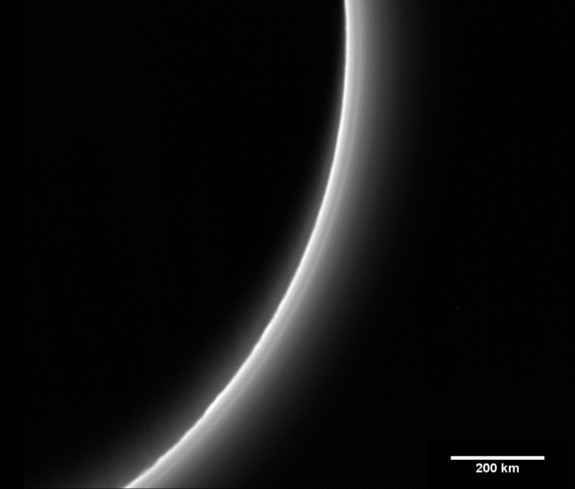
Pluto’s wispy atmosphere is seen in this photo, which was captured by NASA’s New Horizons spacecraft shortly after its closest approach to the dwarf planet on July 14, 2015.
Credit: NASA/JHUAPL/SwRI
Unexpected variations in the brightness of Pluto’s wispy atmosphere may be caused by gravity waves, scientists say.
Newly analyzed images captured by NASA’s New Horizons spacecraft , which flew past Pluto last July, show that the dwarf planet’s haze layers can change in brightness depending on lighting conditions and viewing perspective. However, the haze keeps the same vertical structure.
“The brightness variations may be due to buoyancy waves — what atmospheric scientists also call gravity waves — which are typically launched by the flow of air over mountain ranges,” NASA officials wrote last week in a description of the images , which were captured by New Horizons’ Long Range Reconnaissance Imager (LORRI) during the flyby on July 14, 2015.
“Atmospheric gravity waves are known to occur on Earth, Mars and now, likely, Pluto as well,” the officials added.
Gravity waves are not the same thing as gravitational waves, which are ripples in the fabric of space-time first predicted by Albert Einstein in his theory of general relativity. The first-ever direct detection of gravitational waves was announced earlier this year by scientists with the Laser Interferometer Gravitational-Wave Observatory, or LIGO.

Hazes in Pluto’s atmosphere vary in brightness, as this sequence of images from NASA’s New Horizons spacecraft show. These shifts may be caused by gravity waves, researchers say.
Credit: NASA/JHUAPL/SwRI
The LORRI images were taken in intervals ranging from roughly 2 to 5 hours each, revealing layer brightness variations of about 30 percent. However, the height of the layers was the same in each image, scientists said.
“When I first saw these images and the haze structures that they reveal, I knew we had a new clue to the nature of Pluto’s hazes,” Andy Cheng, LORRI principal investigator from the Johns Hopkins University Applied Physics Laboratory in Maryland, said in the same NASA statement. “The fact that we don’t see the haze layers moving up or down will be important to future modeling efforts.”

The New Horizons mission has made a number of interesting discoveries about Pluto’s atmosphere. For example, flyby observations revealed that Pluto’s hazes extend at least 120 miles (200 kilometers) above the dwarf planet’s surface — far higher than models had predicted.
The hazes also have a blue tint, which comes from complex organic molecules known as tholins that scatter light at blue wavelengths.
Follow Elizabeth Howell @howellspace , or Space.com @Spacedotcom . We’re also on Facebook and Google+ . Originally published on Space.com .
Comments are closed.